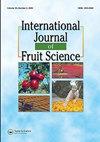Evaluation of Patch Budding Success in Persian Walnut Affected by Different Treatments after Budding
IF 2.4
3区 农林科学
Q2 HORTICULTURE
引用次数: 4
Abstract
ABSTRACT Vegetative propagation of Persian walnut (Juglans regia L.) is more difficult than many other fruit trees. Temperature, relative humidity, water status of the scion and rootstock, nutrient uptake, time of grafting, physiological condition of the rootstock, and scion type all can affect grafting success. An experiment was conducted to evaluate the effects of post-budding irrigation frequency (3, 7 and 10-days), budding date (14 June, 5 and 26 July), and rootstock heading methods. All treatments and evaluations of their effects were performed in field conditions, for two consecutive years. Irrigation cycle, budding date and rootstock heading procedure all had significant effects. Bud take was greatest on 26 July (49.3%). Irrigation frequency had no significant effect on bud take but the 3-day cycle resulted in the best scion growth. Bend the branches to create shade at the bud site, rather than cutting the rootstock above the bud site resulted in the best bud take (61.1%). The results obtained in this study show that budding at the right time “provides better climatic conditions,” adjusting the irrigation cycle and choosing the best rootstock heading methods after budding, produces satisfactory results出芽后不同处理对波斯核桃斑块出芽成功率的影响
波斯核桃(Juglans regia L.)的无性繁殖比许多其他果树更困难。温度、相对湿度、接穗和砧木的水分状况、养分吸收、嫁接时间、砧木的生理状况和接穗类型都会影响嫁接成功。试验评价了出芽后灌溉频率(3、7和10 d)、出芽日期(6月14日、7月5日和7月26日)和砧木抽穗方式的影响。所有的处理和效果评价都是连续两年在野外条件下进行的。灌溉周期、出芽日期和砧木抽穗程序均有显著影响。7月26日采芽量最大(49.3%);灌溉频率对芽生长无显著影响,但3 d的灌溉周期对接穗生长效果最好。在芽位处弯曲树枝遮荫,而不是在芽位以上切断砧木,结果出芽率最高(61.1%)。本研究结果表明,适时出芽“提供较好的气候条件”,调整灌溉周期,选择出芽后最佳的砧木抽穗方式,均能取得满意的结果
本文章由计算机程序翻译,如有差异,请以英文原文为准。
求助全文
约1分钟内获得全文
求助全文
来源期刊

International Journal of Fruit Science
Agricultural and Biological Sciences-Agronomy and Crop Science
CiteScore
6.40
自引率
0.00%
发文量
64
审稿时长
10 weeks
期刊介绍:
The International Journal of Fruit Science disseminates results of current research that are immediately applicable to the grower, extension agent, and educator in a useful, legitimate, and scientific format. The focus of the journal is on new technologies and innovative approaches to the management and marketing of all types of fruits. It provides practical and fundamental information necessary for the superior growth and quality of fruit crops.
This journal examines fruit growing from a wide range of aspects, including:
-genetics and breeding
-pruning and training
-entomology, plant pathology, and weed science
-physiology and cultural practices
-marketing and economics
-fruit production, harvesting, and postharvest
 求助内容:
求助内容: 应助结果提醒方式:
应助结果提醒方式:


